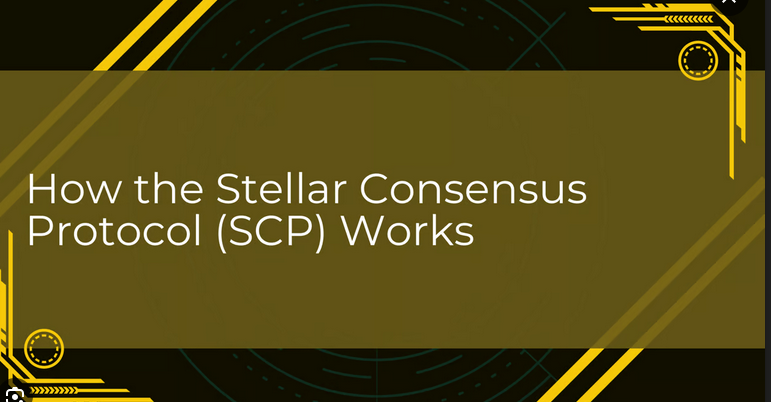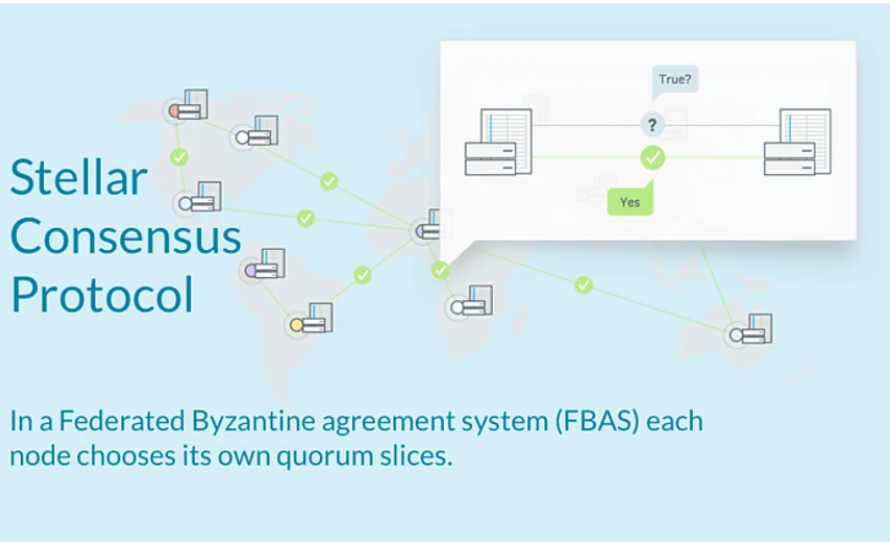Understanding Stellar Consensus Protocol (SCP)
 Joanne Muthoni
Joanne Muthoni
What is consensus protocol
One of the main ideas behind blockchain is that it doesn’t need trust; the community checks if transactions are real. But how does it do this? Different networks use different ways, called consensus protocols, to make sure everything is correct.
Consensus mechanism is the programming and process used in blockchain systems to achieve distributed agreement about the ledger’s state. In short it is any method used to achieve agreement, trust, and security across a decentralized computer network. It plays an essential part in securing information by using automated group verification.
We are going to dive into understanding stellar consensus protocol and how it is different from the proof of work and proof of state.
Stellar Consensus Protocol
The Stellar Consensus Protocol (SCP) is a federated consensus model created specifically for the Stellar network. It offers decentralized control, quick transaction times, flexible trust, and strong security. Unlike Proof of Work (PoW), which relies on miners solving difficult cryptographic puzzles, and Proof of Stake (PoS), which depends on validators holding large amounts of cryptocurrency, SCP uses quorum slices—a group of trusted nodes chosen by each participant to reach consensus.
In SCP, each Stellar Core node (also known as a validator) chooses which other nodes they want to trust. This flexible trust system allows anyone to become a Core node, making the network open and decentralized, with no central authority controlling who gets to vote for consensus.
There are no financial rewards for being a validator on the Stellar network. Instead, people become validators to help keep the network secure and reliable, which in turn supports the products and services built on Stellar.
SCP relies on the Federated Byzantine Agreement (FBA) model. This model allows nodes to agree on transactions based on quorum slices, which are subsets of the network that a node considers trustworthy. Through federated voting, these quorum slices work together to form a consensus, ensuring that the network remains secure and operational.
Components of Stellar Consensus Protocol
Quorum Slices:
In the Stellar network, Core nodes use a system of trust to reach consensus. Each node chooses a group of trusted nodes called a quorum set.
The node also sets a threshold, which is the minimum number of agreeing nodes needed within its quorum set to make decisions
The combinations of agreeing nodes that meet this threshold are called quorum slices.If enough nodes disagree, they can form a blocking set, preventing consensus
A quorum is formed when there's a network-wide agreement, with each node part of a quorum slice. Nodes express their opinions through statements, typically about which transactions to include in a ledger
These opinions are influenced by the node's quorum set, creating a interconnected system of trust and decision-making across the network.
Federated Voting:
The Stellar Consensus Protocol (SCP) uses federated voting to reach agreement. Nodes assess the network's state by consulting their chosen quorum sets. Before full network consensus is achieved, statements progress through three stages of federated voting:
1. Vote
2. Accept
3. Confirm
This process ensures that all honest nodes in the network gradually align on a common decision, building consensus in a decentralized manner.
Federated Byzantine Agreement model (FBA) The Federated Byzantine Agreement model used by SCP allows nodes to reach consensus efficiently while preserving security. The FBA model ensures that the system can continue to function even if some nodes are unreliable or compromised, as long as a sufficient number of quorum slices remain intact.

Understanding Proof of Work (PoW) and Proof of Stake (PoS)
Proof of work (Pow):
Proof of Work is the original consensus mechanism used by Bitcoin and other early cryptocurrencies
It requires miners to compete against each other to solve complex mathematical puzzles, validating transactions and securing the network in the process. While PoW is highly secure, its major drawbacks include high energy consumption and slow transaction speeds, making it less scalable for widespread use.Proof of Stake (PoS):
Ethereum is transitioning from PoW to PoS. In PoS, there are "forgers" instead of miners. These forgers stake a certain amount of cryptocurrency, giving them a chance to be chosen as a block validator based on probability. The successful forger is rewarded with the transaction fees from the block. Staking their own cryptocurrency acts as a deterrent against dishonest behavior because if they try to deceive the network, they risk losing their stake.
PoS reduces the energy consumption associated with PoW and improves transaction speeds. However, it can also lead to centralization, as those with the most wealth have the most influence on the network.
How SCP Differentiates from PoW and PoS
Energy Efficiency: SCP stands out for its energy efficiency. Unlike PoW, SCP does not require intensive computational power, making it significantly more eco-friendly. This efficiency allows SCP to validate transactions quickly and at a fraction of the cost associated with PoW and PoS mechanisms.
Decentralization: SCP maintains a decentralized structure through quorum slices, where each node chooses its own trusted nodes, avoiding the potential centralization seen in PoS. This flexible trust model ensures that control over the network is not concentrated in the hands of a few entities.
Transaction Speed and Scalability: SCP’s federated voting system allows for near-instantaneous consensus, drastically improving transaction speeds compared to PoW and PoS. This rapid consensus process makes SCP highly scalable, capable of handling a large volume of transactions without sacrificing performance.
Security Model: SCP's security lies in its ability to achieve consensus without needing a universally agreed-upon leader or validator. The quorum slices form an intricate web of trust, making it difficult for malicious actors to disrupt the network. This model provides robust security while remaining efficient and scalable.
Impact on Scalability and Security
Scalability: SCP is designed to scale efficiently by allowing the network to process thousands of transactions per second. Its lightweight consensus mechanism avoids the bottlenecks associated with PoW’s block validation process and PoS’s validator selection, making it ideal for high-throughput applications.
Security: SCP provides a high level of security through its decentralized quorum slice structure, reducing the risks of centralization and single points of failure. The federated voting mechanism also mitigates the risk of 51% attacks, which are a concern in both PoW and PoS networks.
Use Cases and Real-World Applications
Stellar’s SCP has been instrumental in powering a range of applications, particularly in cross-border payments and decentralized finance (DeFi) solutions. For example, IBM’s World Wire leverages Stellar’s network to facilitate real-time cross-border payments between financial institutions, significantly reducing the costs and inefficiencies associated with traditional banking systems. Additionally, Circle’s USD Coin (USDC) is supported on the Stellar network, providing a stablecoin option that benefits from SCP’s fast transaction speeds and low fees, making it ideal for DeFi applications. SCP’s ability to handle a high volume of transactions quickly and securely has made it a preferred choice for financial institutions and fintech companies looking to leverage blockchain technology without the energy-intensive drawbacks of PoW or the centralization risks of PoS.
Conclusion
The Stellar Consensus Protocol offers a compelling alternative to traditional consensus mechanisms like Proof of Work and Proof of Stake. With its innovative use of quorum slices and federated voting, SCP provides a secure, scalable, and efficient model for blockchain consensus. As the blockchain landscape continues to evolve, SCP stands out as a beacon of what decentralized, eco-friendly, and robust consensus can achieve.
References
Subscribe to my newsletter
Read articles from Joanne Muthoni directly inside your inbox. Subscribe to the newsletter, and don't miss out.
Written by
